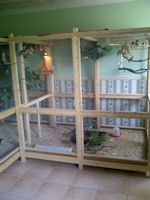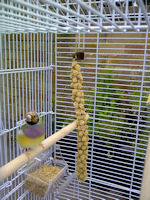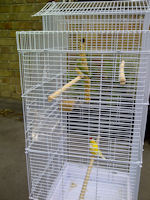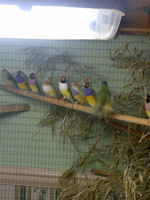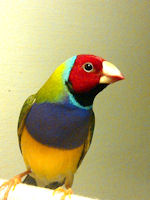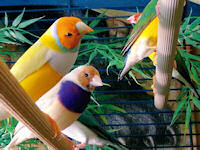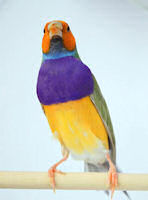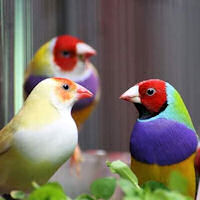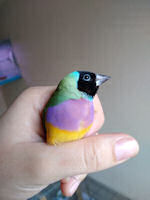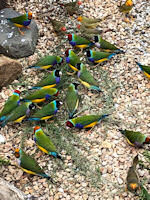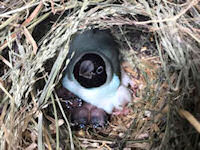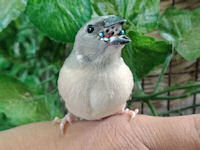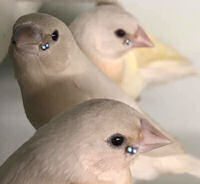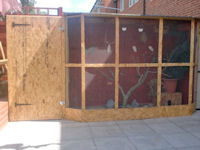Beginners
Introduction
I remember the very first time I saw a gouldian finch, it was at a tabletop bird sale, and I was amazed by its pure beauty. The way the colours blended into each other, had all the colours of the rainbow, the clarity was amazing. I was in awe with the songs from the males, which sounded like no other bird I have ever heard. From that moment I 'knew', I wanted to keep gouldians finches as pets.
Without knowing anything about them, I bought my first pair and proceeded home. On arrival, I was excited to get them into my aviary, see how the other birds reacted, and could not wait to sit and just admire them. For a few days everything was great, no fighting, no signs of sickness, it seemed like everything was going great. About a week later one morning I woke up, went to the cage and noticed one was on the floor sat with its head tucked in, and I was able to pick it up unchallenged. I looked the bird over, noticed it was under weight with a dirty vent. Later that day, the bird died without ever knowing why. This was the day I realized 'I was a beginner' and I had to start educating myself and learn everything I can about these beautiful birds before buying more. I also realized I should have learnt more about them prior to buying them. I was eager, believing I may never get another chance to see one again, so I bought a pair right away, big mistake.
Does any of the above sound familiar to you? Well this is very common and me, like all of us, learn the hard way. There were pretty much no websites then, no applications like the ones I have created today, and few books about gouldian finches. Today I am educated on these birds to a pretty high degree, enough to write a book or applications to provide valuable information. Maybe you have never kept a bird before and are just starting out for the first time, we all start somewhere and what better place to start than right at the beginning. I often wish I could go right back to the beginning but retain the knowledge I have about gouldian finches because I would have lost far fewer birds than I did.
Gouldian finches are probably not the best birds to start off with as a beginner. Gouldian finches are not hard to keep, but do need more attention than most other birds. Some would say that experience comes over time, but I like to think you can take advantage of other people experience by researching the birds first, learn from others and take note of details. Why would you be willing to go through all that heartache and cost by losing them all the time by not learning anything about them first?. I would like to save everyone the money, save the gouldians from sure death, and save you all that heartache by advising you to learn as much as possible about the gouldian finch first before bringing any home. Join groups, clubs, forums where you can get lots of support but never be afraid to ask lots of questions.
Let us assume you have already researched the gouldian finch, not only have you researched but actually learnt their basic needs. You are feeling confident you have learnt about their breeding cycle, eating habits, their environmental requirements, their vulnerabilities etc. You feel ready to bring home your first gouldian finches. Once you have made your decision to bring one or more home you will need to decide where to keep it, what type of cage or aviary, make sure you have the right perches, drinkers, feeders, baths, cuttlebone, sterilized eggshells, crushed oyster shells, carbon granules, bedding for the floor, fake or real foliage, all the required supplements, the correct lighting (if kept indoors), good quality dust free seed and register with a local avian vet. Yes, there are a lot of other things you will need to help get you started, but the above are generally the basics.
If your intentions are to breed gouldians to make a living or as a form of income, forget it, they cost more to look after and raise than you will ever make. Supplements alone can cost a fortune, and so can preventive medicines. When weighing up the cost it takes to keep gouldian finches you have to look at the list, electricity for heating and lighting, new light bulbs, light case replacements, the cage or aviary are not cheap to buy or build, drinkers, feeders, baths, floor substrates, nesting material, nesting boxes, supplements (multivitamins, liquid calcium, amino acids, carbon granules etc), cuttlebone, vet bills and other medicines, seed, fresh veggies every day and much, much more. There is too much to list, really, but I am sure you understand as I point it out. By the time I sell my birds, I make only a fraction back, but usually it's a big loss.
If anyone can make a profit from selling gouldian finches, then avoid them because those birds would have probably been deprived of all the much-needed nutrition which is vital to their health and wellbeing. The only way to make money from this hobby is if the breeder can get all of their supplies for free or not give the birds what they need to be healthy. Cheap brands are cheap for a reason, they are usually not very good (some being watered down) and some don't work at all. There are some great brands out there but cost a lot of money and this is where you lose money over time when selling any offspring. I would avoid skipping medicines, supplements or any other cost-cutting ideas because your birds will pay the ultimate price also people will not buy birds that look unwell.
Once you decided you want to keep gouldian finches, you should start looking for reliable breeders who can be trusted to sell you quality birds and will give you some kind of guarantee. Get to know more people by joining more groups and learn about new breeders local to you. You may have to travel long distances to acquire new quality birds, but by doing so gives you a better chance of not buying birds related to birds you already have, thus producing a new bloodline. Since I have been selling birds over the years I have sold so many that I now have to be careful that I do not buy back the same bloodline as I sold. Keeping a small group of gouldians for breeding will often lead to inbreeding or linebreeding, which should be avoided for genetic reasons.
There are various colours of gouldian finches these days with new colours being produced all the time, I tend to avoid the blue back gouldian because of various reasons. The blue back gouldian finch seems to have a much shorter lifespan and is well known for having genetic issues as well as being prone to bacterial infections. They are a relatively new colour and have been interbred a lot since they were very rare at the beginning, and this interbreeding is believed to have been the cause of the genetic disorders. With time, we hope that more new blue back gouldian finches will be produced, so they can breed without the genetic problems the present ones have. As a beginner, I would strongly advise against buying any blue back gouldians and buy only green back or yellow back gouldian finches. In a few decades, who knows, maybe there will be a stronger blue back that will not die so soon or have genetic problems.
There are many other species that should never be housed with gouldian finches, in fact, gouldian finches should really be housed with their own species to avoid fighting or stress. You may have the most placid bird on the planet, but under the wrong conditions they can turn nasty and find either your gouldian sick or dead. Male gouldians will spend most of their time sat singing to themselves, whilst the hens will sit quietly chilling out. They do have spells where they are super active, but that is usually short-lived. The only birds I would trust being housed with gouldian finches are society finches, otherwise known as Bengalese finch. Quite often I have seen juvenile gouldian finches begging for food only to find the society finch nipped over to feed it. Sometimes when a gouldian finch abandons the nest, a society pair will move and foster the eggs or chicks and even raise them as their own.
A common phrase I have heard from other people about keeping gouldian finches is that they are hard to keep or that they always die, but it is not true, as mentioned previously it is all about knowledge. Learning about them first and being prepared before you get any will prove those rumours to be untrue. Too many people buy them on the spot with no previous knowledge on how to look after them and later fail in their attempt because at the time they knew nothing about them. All this hearsay is enough to put anyone off keeping them, but those who are determined to keep them and want to learn often end up being successful. Any bird can be hard to keep if nothing is known about them, but we learn over time through trial and error.
If you already have gouldian finches you may notice at nights they are frightened very easily by sudden strange sounds, flashes of light such as lightening or car headlights, vibrations but this is common and some can actually hurt themselves as they fly about in the dark aimlessly hitting the walls of the cage. For those that are kept indoors, I will switch on a low level (dimmed) light, so they can find a perch to rest on after falling. Most of the time injuries are caused because they can not see the wire mesh in front of them and are unable to find a perch, so a low level light can really help. Many older birds whom you have had for many years rarely panic overnight because they know most of the sounds and are familiar with their surroundings.
I would encourage anyone who has children to get them interested in keeping gouldian finches, they are super great little birds and can be very friendly once tamed. Maybe one day they might try their hand at hand rearing any abandoned chicks whilst learning more about them. Maybe one day you may buy them an incubator, so they can watch the embryo development and hatching process. Since keeping the gouldian finch I have never looked back, they are so rewarding, their songs would brighten up anyone's day. My younger sister bought an incubator for her children when they had some abandoned eggs, they placed the eggs in the incubator to see if any would hatch. First thing every morning the children would get up, rush downstairs to see if any had hatched and would spend a lot of time just looking at the eggs. After a nearly 2 weeks finally one morning they got to see all the eggs hatch, their faces were filled with excitement and could not believe what they were seeing. It is an experience all children should have, to let them know how birds are born.
There are a few other things to keep in mind before buying any gouldians or any bird for that matter is can you afford to keep them their whole lives? Do you have the room for them? Do you plan to breed them or just keep them as pets? Do you have a local avian vet where you can take them if they become ill? Can you supply the right environment for them to live a comfortable life?. These are questions you need to ask yourself prior to bringing home any bird. If you can provide everything they need and still want to be a proud keeper of gouldian finches, then I wish you the very best of luck.
